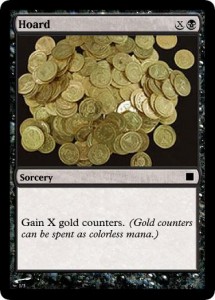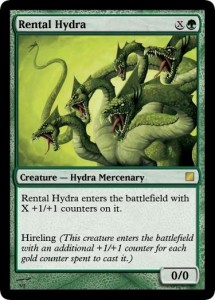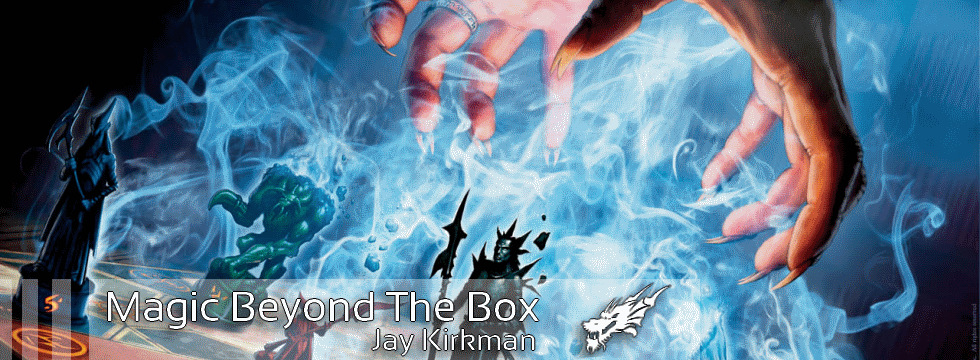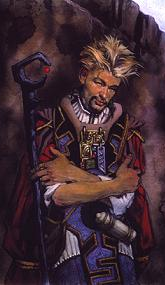Are you a Quiet Speculation member?
If not, now is a perfect time to join up! Our powerful tools, breaking-news analysis, and exclusive Discord channel will make sure you stay up to date and ahead of the curve.
We're halfway through our Great Designer Search 2 journey, and we've already seen quite a bit! From the evolving dinosaurs of Ethan Flesicher's Epolith to the subterranean prison of Scott Van Essen's Malgareth, the latest design challenge (building an intro deck) has yielded some very intriguing concepts and cards.
For those just joining us, I was asked by the four finalists to give their decks a run through the paces in a sort of "precon gauntlet." As one of the faces behind the precon reviewsite Ertai's Lament, this was a natural fit: we had all the decks boxed, sleeved, and ready to go up against the best the aspiring designers could throw at us. Using decks ranging from Magic 2011's Stampede of Beasts (to test creature efficiency) to Scars of Mirrodin's Myr of Mirrodin (tempo play) to Worldwake's Fangs of the Bloodchief (monoblack aggro), we wanted to see how balanced the designer's decks were when paired off against what Wizards had to offer. We created a gauntlet of seven precon decks from Standard-legal sets, and determined that we'd pit the designer's deck against the gauntlet in seven three-game rounds.
The Great Designer Search 2 series on Quiet Speculation presents the results of those findings. Today we're covering the third of the four decks, this one submitted by Devon Rule, which we took to calling 'Utopian Gold' in the absence of a title.
Devon Rule: Utopian Gold
The World: Utopia. "Let the tools of peace become the weapons of war."
The Mechanic: Devon featured two mechanics in the deck, gold counters and hireling. Gold counters were an additional resource that could be accrued through several means in the game, and could be 'cashed in' for colourless mana at a 1:1 exhange rate (think 'Eldrazi Spawn tokens,' but without being creatures). At one time they could also be used to gain life, and while that eventually was cut they later gained the ability to used to cover life payments (for example, Sign in Blood). Hireling was a related ability meant to convey the influence of gold in a mercenary world. Creatures with the hireling keyword would come into play with an additional +1/+1 counter for each gold counter spent in casting them. Very clean and simple, we were excited at the premise and the possibilities it offered.
The Deck: Devon's deck was a Black/Green assemblage with a very pleasing creature curve (3-2-5-5-7, with one X-creature). Although the back end was a bit bloated, the entire notion of gold counters seemed to indicate that ramp would be readily available. Utopian Gold's beaters could be divided into three types. (Once again, we made the mockups for this deck, so no blaming Devon).
 The Rampers: Devon made sure that gold flowed freely in the streets of Utopia, and that ways to accrue them were both abundant and easily accessible. A trio of Lotus Peddlers were essentially Llanowar Elves that generated gold rather than Green mana. The Smugglers were 2/2 bodies for three mana which generated 2 gold counters whenever they dealt combat damage to an opponent, and the deck contained three of them as well. Finally at the top of the heap was the Ageless Patrician, a 4/4 flying, trampling vampire for five mana that gave you a gold counter for each point of combat damage it dealt to a player (think Rapacious One). In Utopia's economy, there were plenty of ways to earn your daily coin.
The Rampers: Devon made sure that gold flowed freely in the streets of Utopia, and that ways to accrue them were both abundant and easily accessible. A trio of Lotus Peddlers were essentially Llanowar Elves that generated gold rather than Green mana. The Smugglers were 2/2 bodies for three mana which generated 2 gold counters whenever they dealt combat damage to an opponent, and the deck contained three of them as well. Finally at the top of the heap was the Ageless Patrician, a 4/4 flying, trampling vampire for five mana that gave you a gold counter for each point of combat damage it dealt to a player (think Rapacious One). In Utopia's economy, there were plenty of ways to earn your daily coin.
The Hirelings: Of course, what good is making money if there's no way to spend it. Seven of the decks beaters had the hireling ability, meaning you could make them bigger if you spent Gold to cast them. The Garden Guard was a 2/2 for two mana, which could become as big as a 4/4 if your coin purse was jangling. Scary Dude was a 1/1 for three mana, but carried the additional ability of intimidate. Finally, the Hired Killer was a 2/2 for four, and he had a very good incentive for using your hard-won gold: whenever the Hired Killer entered the battlefield, it would destroy target creature with power less than the Killer's. Dig deep for two Gold, and you could kill a 3/3 or less with it (remember, Gold only produced colourless mana, so the most you could spend on the Killer was two). Here too Devon had provided a best-in-breed in the form of the rare Rental Hydra. The Hydra was a hireling and cost one Green and X, entering the battlefield with X +1/+1 counters (like a Feral Hydra or Protean Hydra, but with hireling instead of their other special abilities).
The Rest: Intro decks tend to carry around a fair amount of vanilla or 'French vanilla' creatures. Not only are these simpel to grasp for the newer player, but they also are easy to replace once that newer player decides they want to take a crack at deckbuilding. Of the three decks we'd looked at thus far, Devon seemed to have covered this base the most thoroughly. Green Fat was a 6/6 for six mana, right 'on the curve' but with no special abilities. Black Flyer was a 3/2 drake with flying, and Pet Spider was your traditional Giant Spider but strictly bettter with the addition of vigilance. Guard Baloth was a 4/4 with vigilance, while Final Beater was a 5/8 trampler with haste. The final two creatures here were a little more unusual. The Vault Shade was a 2/2 for four mana that had pumpable power for colourless mana. Typical Shades will do this with Black mana, but Devon clearly wanted to give an outlet for the spending of Gold counters here. Finally, Goldbreather was a 6/3 Elemental that could regenerate for 1 Gold.
Noncreature Support: Devon also seemed to do his homework in the realm of the noncreature spells included in Utopian Gold, for the cards chosen felt very much like your typical intro deck auto-includes. A dose of removal (three [card Doom Blade]Doom Blades[/card] and Degrade, a cheaper Desert Twister that couldn't target creatures). There was the requisite creature aura (Sneaky Stab, which gave its target intimidate and could be sacrificed a la Fires of Yavimaya for a +2/+0 bonus until end of turn), combat trickery (Underrun, which gave X target creatures +2/+2 and trample until end of turn, an Instant version of Overrun), equipment (My Axe, which offered +2/+0 and trample), and a trio of Lotus Gardens. These were a bit like Fertile Ground but added Gold counters rather than a second mana of any colour. Finally, there were a pair of Hoards, another X-spell which converted mana to Gold.
In summary, you had early options for accruing Gold, which you could then spend through the midgame to power up your creatures. Between the [card Doom Blade]Doom Blades[/card] and the the Hired Killers, removal is available for clearing a path through the red zone. On with the amassing of wealth!
 The Playtest: It was here that Utopian Gold went off the rails in ways that we hadn't quite put together when we assembled the deck. In our very first matchup, I piloted the deck against the White-weenie Kor-fest, Kor Armory, and had a startling series of events.
The Playtest: It was here that Utopian Gold went off the rails in ways that we hadn't quite put together when we assembled the deck. In our very first matchup, I piloted the deck against the White-weenie Kor-fest, Kor Armory, and had a startling series of events.
Turn 1: Forest, Lotus Peddler
Turn 2: Swamp, tap the Lotus Peddler for +1 Gold
Turn 3: Swamp, tap the Lotus Peddler for +1 Gold
Turn 4: Forest, cash in 1 Gold and tap out for Ageless Patrician. Tap the Lotus Peddler for +1 Gold
Turn 5: Attack for 4 with Patrician (adding +4 Gold counters). Tap the Lotus Peddler for +1 Gold. I now had 4 land and 7 GC. Tap out and cash out all of my Gold for colourless mana, paying one Green and ten colourless for a 10/10 Rental Hydra. Because of the Hydra's hireling ability, it got an additional +1/+1 counter for each Gold I spent on casting it. The result? I just squeezed a 17/17 Rental Hydra onto the battlefield.
Turn 6: Put Sneaky Stab onto Hydra, giving it intimidate. Swing for an unblockable 17 points of damage.
Turn 7: Kill opponent. I might have done it a turn sooner, but my opponent had a Pacifism for the Ageless Patrician.
The series of events was so incredible, we walked through it several times. Did we do something wrong? Were we misreading the card? The mechanic? Over and over, we came to the same conclusion. A 17/17 beater. Turn 6.
We took the card for broken- hey, it can happen- and solidered on. Until the very next game we had a similar turn of events happen that landed an early Final Beater. We soon learned that if your opening grip contained a Gold generator (especially the Lotus Peddler), you were probably going to win that game. We finished 2-1 against the Kor, 2-1 against Rapid Fire, and 3-0 against Phyrexian Poison. Something was broken, and there was no point continuing until it was fixed.
We emailed Devon our initial conclusions, including the turn-by-turn sequence which broke Rental Hydra, and stated:
We’ve run the deck through a partial leg of the gauntlet- three decks rather than the 7 we’ve normally done. In doing so, we’ve identified what we feel are some critical problems with the underlying mechanic of the deck that you may want to look into. We thought it better to let you know now and give you the maximum time we could to address these rather than run a late-nighter and leave you scrabbling for time.
Our area of concern involves the Gold Counters. On the face of it, I love the idea. I read somewhere that someone said it sounded very “Settlers of Catan-y,” and enjoyed the novelty of a new resource. So subtle is its underlying break that it wasn’t anything I even noticed at all until I played my first game. And like one of those things you can’t unsee after you see it, it was there in most every game.
 In short, the ability of mana to be hoarded in the early game has the consequence of being massively swingy, because you can reap a ton of Gold Counters early and make some truly sick plays. Second, swingy outcomes are hard to predict and, therefore, hard to plan for. You might tone the deck down some to diminish the risk of such upper-end results, but then is there enough in the deck to hold steady when you don’t get any such accelerants at all?
In short, the ability of mana to be hoarded in the early game has the consequence of being massively swingy, because you can reap a ton of Gold Counters early and make some truly sick plays. Second, swingy outcomes are hard to predict and, therefore, hard to plan for. You might tone the deck down some to diminish the risk of such upper-end results, but then is there enough in the deck to hold steady when you don’t get any such accelerants at all?
One more anecdote to illustrate our concerns. In our third and final round of games, I was facing Phyrexian Poison, which is the Infect deck from SOM. By now I’d absolutely brutalised my opponents, so I decided to keep an amusing hand for a lark and see what happened. It had one land only- a Forest- a pair of the Lotus Peddlers, and on top of that it even had a Doom Blade, which was useless against much of Phyrexian Poison (Black critters).
Was early Gold nasty enough to take even this bad start and clean up? It sure did- on turn six.
The things this deck is capable of make it feel Constructed (even Legacy) when up against other Intro Decks. I don’t know how to fix Gold so that it has the opportunity to balance. I love the feel of it as a mechanic, the Hireling concept is a lot of fun and we had a great time with it. It almost feels like Gold shouldn’t be redeemable for colourless mana, because that’s where it gets tricky, but rather be a self-contained mechanic. The last time WotC gave us the ability to store mana like a battery was in Rise of the Eldrazi, and that came at the additional ‘cost’ of making that fragile. One Pyroclasm and your ‘bank account’ just got cleaned out. Gold has no counter.
Devon, I feel very strongly that trading in Gold for mana breaks your mechanic, but I think the idea is so rich and flavourful that I actually get anticipatory jitters thinking about it divorced from the mana problem. Finding ways to accrue “money” and spend it through your guys hits the same sort of pitch-perfect fusion between flavour and mechanic that the Levelers did in ROE. This seems far from the mechanics I saw in this deck, but rather similar to what seems to be your vision.
I hope this helps and isn’t too discouraging. I’d love to see you pull this off- it’s not often we get something really fresh and exciting like this, even from WotC! Let me know if you have any questions about what we’ve seen.
Devon tweeted us once, to let us know that he'd seen no such results in his own playtesting. We never heard back after that.
In our final article of the Great Designer Search 2 playtest series, we'll be looking at Shawn Main and his ultra-lethal Blight mechanic. See you then!







So make the lotus peddlers cost two instead of one, or make the ability cost 1colorless, or make their ability only activate when they themselves have a +1 counter. Or make it an artifact that CIP tapped. Or give gold a lifespan of 3 turns, or cap it at 5 at any one time. I hope Devon isn't discouraged, the mechanic is very intriguing and I hope he works through this.
I am curious to see how the final submission's modification of Lotus Peddlers changes things.
Lotus Peddler (Common)
G
Creature – Elf Druid
1/1
1, T: Gain one gold counter. (Gold counters can be spent as colorless mana or life payments.)
Since you have to pay a mana before you get a Gold Counter, it's pretty much equivalent to the storage lands from Time Spiral. Strong, but it comes with a transient loss of tempo.
In any case, this series of assessments have been great. Thank you for writing them!
That's definitely an improvement, but like you I'd be curious to see if it was enough of one. There were still other ways of getting fast, early gold in the deck version we playtested, though none faster than our friendly Peddler here. I'd have fixed the hireling hydra too… hireling is a novel mechanic, and it's good that it has a hard cap on it based on how much colourless mana is needed to cast the critter. This gives it some balance. Having an X-creature throws that limitation right off. There is some precedent for larger critters in an intro deck with ROE's Invading Spawn and Eldrazi arisen, but there they have a flavour and theme that was a core component to the set and the decks were built around them.
It was such a luck-into, we'd honestly thought we'd done something wrong. You can imagine that this sort of thing happens all the time at Wizards.